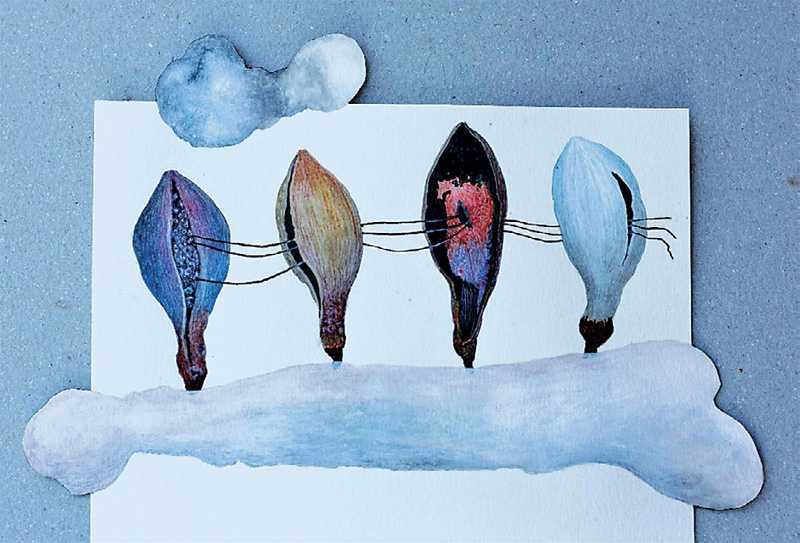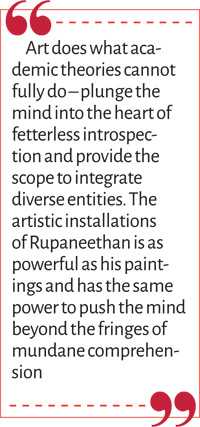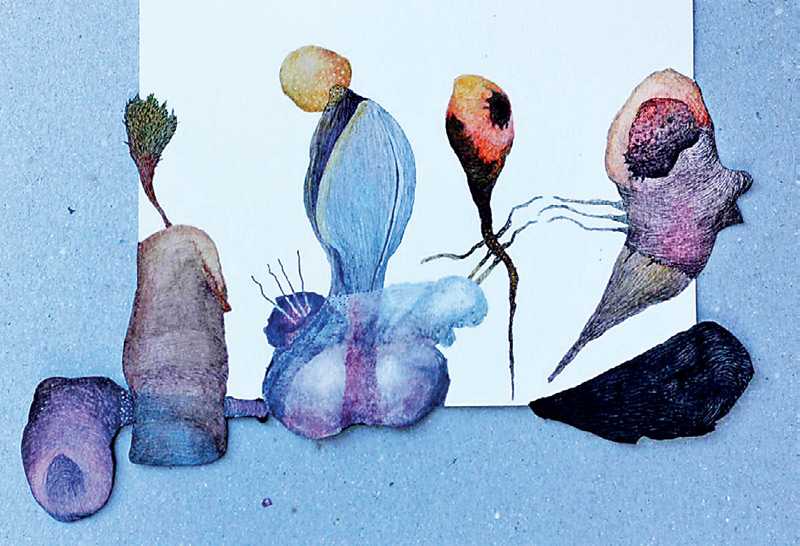Friday Apr 26, 2024
Friday Apr 26, 2024
Saturday, 10 April 2021 00:10 - - {{hitsCtrl.values.hits}}

Review of the solo art exhibition by Rupaneethan Pakkiyarajah being held at the Paradise Road Art Gallery from 1 to 28 April
By Surya Vishwa
|
Rupaneethan Pakkiyarajah
|
What is art? Where does it begin and where does it end? What are the boundaries of imagination? And where do these boundaries merge with the real? What is real – what is right and what is wrong – within what we know as reality? What is this reality? Isn’t this reality one dimensional or are there many interpretations, many narratives, each narrative leading to another like the layer of an onion being peeled? How important is it for these narratives to surface so that they touch our mind and most importantly our heart, making us grow in wider empathy and awareness. These are few of the questions that may assail the viewer trying to understand the art of this 30-year-old Batticaloa-based artist who had in 2016 received his Bachelor of Fine Arts in Art and Design (Honours in Sculpture) at the University of Jaffna. In 2020 he had completed an online course facilitated by the Public Art Practice in Place-Shaping, from Lahore, Pakistan based Mariam Dawood School of Visual Arts and Design at the Beaconhouse National University.
Titled ‘A search for connectivity’ the exhibition consisted of mixed material based installations and the paintings. The paintings were created with the use of ink – some of them in light colours – and others in black and white – paintings framed in paper between 38cm x 44cm of size. The comparative smallness in size of the paintings and how they were positioned at the exhibition in line with direct eye contact enabling a close intimacy with the narrative as told by this East-based artist whose childhood and youth had made him, as the whole of Sri Lanka, to be bystanders of a difficult epoch in Sri Lanka, the three-decade-long civil war.
Yet, it is possible that a mere glance at his work would not make one guess that there could be subconscious elements of his childhood or youth based impressions embedded in them. This was apparent when one foreign visitor at the exhibition asked the artist if the war had in anyway influenced him. I did not specifically ask him this question. For me, being from Sri Lanka, the answer was obvious because no sensitive artist whether from north, east or south, whether his art medium is words or colours or objects, could fail to be influenced, in whatever subtle or overt manner on what transpires within the immediate sphere of his existence, the land he lives in.
The installations were more direct in conveying the imagery and if scrutinised closely would show the artistic contemplation behind them, but as I found out in my discussion with the artist, his creations were mostly derived from the subconscious, whether installations or paintings. In this state the artist’s conscious mind is only vaguely aware of the logic of his creation and after the birth of the full work the interpretations of the viewer including that of the artist would vary as both the artist who created the work and the person who views his work would both be equal guests to the revelation by the subconscious brush of the mind. 
The title of the exhibition on connectedness is very apt; the works speak of connectedness at different levels with nature connectivity between the inner mind and the outer, the land and the sky, the animate and the inanimate, rootedness and uprootedness, the narrative and the counter narrative, the birth and the death. The installations meanwhile experiment with varying material that has opposite quality; such as metal and plastic, the painting style is surrealistic and reminds one of the Spanish artist Salvador Dali. Not surprisingly Rupaneethan’s favourite artist is Salvador Dali.
Like the artwork of Dali the compositions of the subject matter that make up the artistic revelations are a sometimes jarring juxtaposing of opposing entities – a punctured pipeline upon which is a miniature structure seemingly made up of twigs which has what can be interpreted as a nest made of gossamer. Titled Asystasia Gangatica and Land, this painting is part of a series that seems to speak of the complex nature of migration and uprootedness. The human connectivity with the land and nature dominate the landscape of the artistic vista of Rupaneethan. Nature abounds in his canvass, in the form of pollen, newly born plant bulbs or pods, trees and clouds. Clouds are used often to define the imagery of the consciousness and seem to act as a prodding agent for the viewer’s mind to come up with its own storyline of the painting.
In another painting under the series titled Asystasia Gangatica and Land, I saw which to me looked like a patch of a cloud in the shape of bones with pods of new plant life in different colours taking root on it, with the pods woven through with a line of strings while on the edge of the frame of the canvass – running outside it there was a seemingly small cloud that could be anything – even an embryo. Having given this description it could be pointed out that artistic interpretation is subject to conjecture and that even in the sphere of literature it is said that no two readers read the same book in the same way.
Therefore most elements of Mother Nature, plants, clouds, birds and even trees exist on Rupaneethan’s canvass each telling probably a different story to each different mind. In this artist’s work, the docile and plaint such as found in nature collide with the violent such as those associated with man-made wars. Hence this could be seen as an intermixing of the natural form of existence as it is, with a reality that is corroded by the human wish to conquer, whether it is a piece of land or people’s mind, whether it is injecting the land and the mind with fear and misconception or whether it is liberating the truth from the lie or the lie from the truth or realising that there is neither but just a grey expanse.
Art does what academic theories cannot fully do – plunge the mind into the heart of fetterless introspection and provide the scope to integrate diverse entities. The artistic installations of Rupaneethan is as powerful as his paintings and has the same power to push the mind beyond the fringes of mundane comprehension.
This exhibition is just one in the recent times which show that Sri Lanka has enormous potential to use art, in its diverse forms, for national reconciliation. This should be done without judging – without condemning and without labelling that art southern or northern or eastern. Introspective and retrospective art of this calibre is needed for exposure within spheres of ordinary life; to be communicated to ordinary youth outside Colombo and its elitist circle – this kind of art has to be communicated to youth the same age of Rupaneethan, to take the country on a belated journey to move forward from the past.
Art that bridges the past and releases the country to a stable future needs to move into minds of all Lankans.
This is a need for Sri Lanka as we soon approach the 12th year of ending a prolonged and dismal chapter in the island to allow a freedom of expression in art to convey its messages to bridge the borders of our interpretations so that all youth of Sri Lanka would be an united force in protecting the people and the country collectively and enjoy the right to live in their land, whichever part of the country, without bloodshed or terror or division or oppression of any form.
The process of moving forward is easier said than done for those who went through Sri Lanka’s terror struck recent history; but we are constantly shaped by larger inner and outer conflicts that surround us whether they are mental or physical or material. All these truths are part of a larger tapestry of art not yet manifested in the process of national reconciliation – and in the process of bringing about understanding between communities there is the dire need to join together the force of humanity to surmount whatever that were their experiences and to do so without agendas. Art as a catharsis should be encouraged to be used by the whole of Sri Lanka, whatever the geographical location.
As Sri Lanka commemorates next month yet another anniversary of a saga that cost this nation thousands of young lives and described under various names including war against separatism, we need art to salvage and heal our souls.
